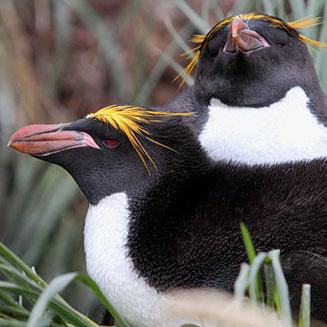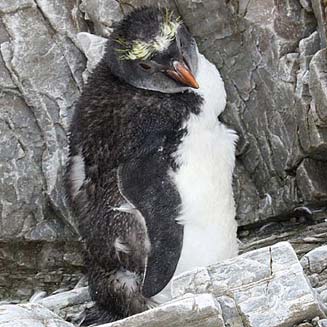|
Eudyptes chrysolophus (Macaroni
penguin)
Langkuifpikkewyn, Macaronipikkewyn [Afrikaans];
Macaronipinguďn [Dutch]; Gorfou doré [French]; Goldschopfpinguin [German];
Pinguim-de-tufos-dourados [Portuguese]
Life
> Eukaryotes >
Opisthokonta
> Metazoa (animals) >
Bilateria >
Deuterostomia >
Chordata >
Craniata > Vertebrata (vertebrates) > Gnathostomata (jawed
vertebrates) > Teleostomi (teleost fish) > Osteichthyes (bony fish) > Class:
Sarcopterygii (lobe-finned
fish) > Stegocephalia (terrestrial
vertebrates) > Tetrapoda
(four-legged vertebrates) > Reptiliomorpha > Amniota >
Reptilia (reptiles) >
Romeriida > Diapsida > Archosauromorpha > Archosauria >
Dinosauria
(dinosaurs) > Saurischia > Theropoda (bipedal predatory dinosaurs) >
Coelurosauria > Maniraptora > Aves
(birds) > Order: Ciconiiformes
> Family: Spheniscidae
 |
 |
|
Macaroni penguins, Cooper Bay, South Georgia. [photo Trevor Hardaker ©] |
Moulting immature Macaroni penguin, Brandfontein,
South Africa. [photo Johann Grobbelaar
©] |
Distribution and habitat
Breeds on sub-Antarctic islands, as well as islands off
Chile and the Antarctic Peninsula, dispersing in the non-breeding season to the
sea, although the range of its movements are unknown. It is a rare vagrant to
southern Africa, with roughly 8 records of moulting individuals along the
shoreline of the Western Cape and one in KwaZulu-Natal, with only a single bird
recorded at see off the coast of Cape Town.
Food
It mainly eats crustacean zooplankton, supplemented with
squid and fish, especially lanternfish (Krefftichthys andersonni). It
mainly forages between 10-80 metres beneath sea level, rarely up to 150m, moving
at roughly 7-8 km/h.
Breeding
Breeds in tightly-packed colonies, which over time erode
ground down to bedrock with trampling.
Threats
Not threatened.
References
-
Hockey PAR, Dean WRJ and Ryan PG 2005. Roberts
- Birds of southern Africa, VIIth ed. The Trustees of the John Voelcker
Bird Book Fund, Cape Town.
|
